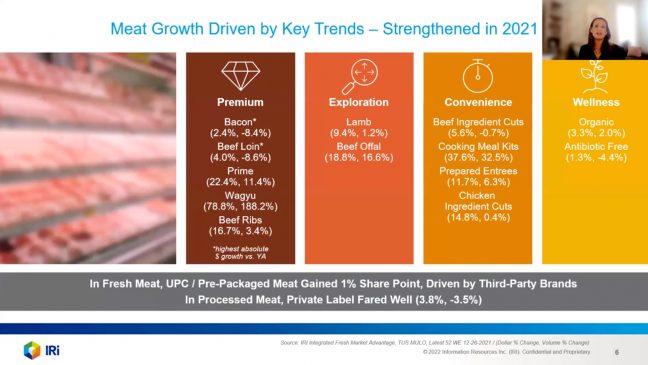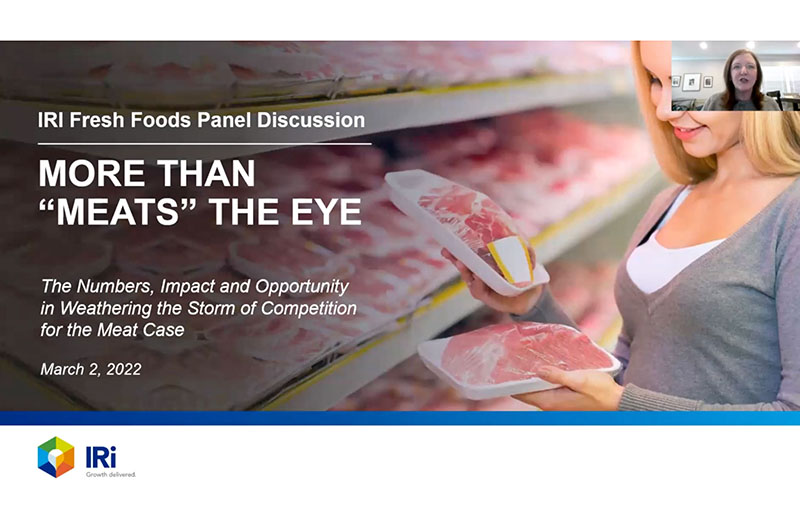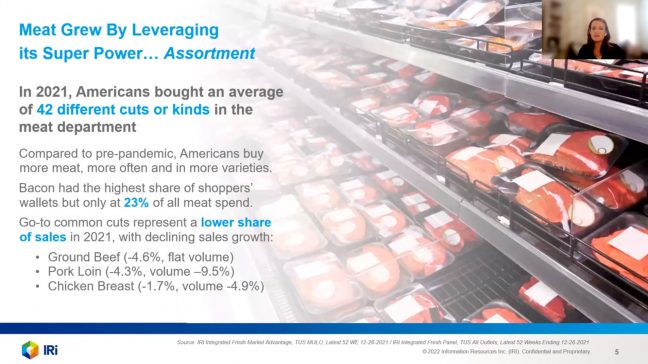To Jonna Parker, many of the macro disruptions in the food ecosystem resulting from the COVID-19 pandemic have actually favored meat.
“I would argue no department changed as much for American consumers than meat,” said Parker, principal of fresh foods at IRI. Her remarks came during a virtual presentation that covered the latest data IRI has gathered on the meat industry.

Some statistics highlighting the impact on meat included:
• 2 percent of average meals were made in home;
• The meat industry reported $82.2 billion in 2021 sales, 45 percent more than 2016;
• $86.30 is spent across the store when meat is in the basket; and
• 8.5 percent of U.S. households bought meat in 2021 and made 50.4 trips annually to do so.
Although many disruptions have made their way into food retail following COVID-19, companies can come to understand the opportunities and capitalize on the ways consumers define value today.
The session was titled, “More than Meats the Eye: Understand the Numbers, Impact and Opportunity to Weather the Storm of Competition in the Meat Case.” Parker was later joined by Heather DeLuca, VP of meat at Associated Wholesale Grocers, and John Crowder, head of marketing – beef at JBS USA. They discussed what lies ahead and how to further grow meat retail sales in 2022 and beyond.
Meat did grow by leveraging its assortment. In 2021, Americans bought an average of 42 different cuts or kinds in the meat department. Bacon had the highest share of shoppers’ wallets but only at 23 percent of all meat spend.
“In fact, no single cut or kind commands more than a quarter of all dollars spent in the meat department. It truly takes us all to make up that shopper’s needs,” Parker said.
However, more common cuts like ground beef, pork loin and chicken breast represented a lower share of sales in 2021, with declining sales growth.
Heavy and light meat buyers
IRI’s analysis of heavy versus light shoppers in the meat department brought forward some new findings.
“Households who spend over $600 annually in the meat department are more plentiful and driving growth faster than their medium and light spending counterparts,” Parker said. “In essence, heavy meat buyers are more important than ever before.”
If one is personifying this buyer, it’s a traditional family with a head of household being a Gen X or Boomer, they have three or more people in the home. And specifically, the children are aged 12 years or older.
IRI reports that heavy meat shoppers are heavy grocery food buyers in general, with meat as the trip anchor:
• 97.86 versus $50.86 when meat is not in the basket;
• 40 more grocery store trips annually than the average American household; and
• Spend $5,944 annually on all food and beverages. This is 78 percent more than the average shopper.
On the other side, Parker said light meat buyers are just as vital today, even though they buy meat far less often – 14 trips annually.
“There are 63 million light meat department buyers, so while everyone buys meat, the majority of consumers spend $300 or less annually,” she said. “These lighter consumers are double the amount of households than we have is heavy.”
Light buyers are still increasing their spend of fresh meat, but they’re more likely to go with historically perceived leaner cuts like pork, chicken and turkey. They also are dabbling in meat alternatives and view seafood as interchangeable with most of the meat market.
These consumers are likely to be between 30 to 40 years old. The household is likely to have one to two people and are less likely to have children present. On average, they spend $73 when meat is in the basket.
“So why is all this so important? Because frankly, meat grew a ton in the last few years…3 percent more pounds and 22 percent more dollars than in 2017. And you see the numbers there, $82 billion industry now – 23 billion pounds,” Parker said.
Group discussion
DeLuca and Crowder later joined the discussion to comment on their greatest takeaways from Parker’s presentation. For DeLuca, assortment and innovation came to mind. But she wants people to think about innovation differently.
“The data tells us we have the research, we have all the information we need that says ‘this is what’s growing, this is what that younger shopper is looking for,’” she said. “And if we aren’t focused on expanding that space, whether it’s fixed weight versus random weight, whether it’s different packaging types, label claims, better-for-you, convenience…if we aren’t focused there, we’re not going to grow.”

Crowder echoed the sentiment of opportunity ahead in the industry.
“It’s really about assortment and assortment optimization, the premiumization that’s going on in these categories supported by increasing quality,” he said. “I know in beef, our quality here in America just continues to get better and better. So, cattle raised in the U.S. are the most sustainably raised cattle on the globe. And they also are the highest quality. There’s a growing global demand for USA beef. And we’re all over that. But more importantly, consumption of beef in the United States is at an all-time high.”
When Parker asked what type of consumer DeLuca and Crowder would like to see the meat industry have a greater focus on, DeLuca started with the light meat buyers.
“What I think is interesting is looking at kind of where some of those indexes are in terms of what that light consumer is leaning toward,” she said. “…What are we doing to communicate the health and wellness attributes that meat brings and doesn’t get credit? Protein is the biggest one.”
Crowder emphasized the importance of highlighting the health benefits associated with beef.
“All beef has so many vitamins and minerals. And as an industry, and as a manufacturer, retailer, all of us – we’ve done a poor job at telling consumers just how many vitamins and minerals are in a three-ounce serving of beef.”
The assortment of beef is an important decision maker for consumers, which Crowder pointed out.
“We did a study last year, 73 percent of consumers say that assortment of beef is a critical factor, when they decide where they’re going to go shop. They’re thinking about what kind of beef can I find at this store? Will it fill my needs? That’s a trip drive. And so, assortment is the real key, not the front-page ad price, right?”
To view the full presentation from IRI, click here.


